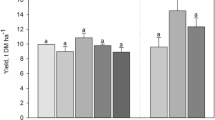Abstract
When the rate of N fertilization was increased from 36 lbs/acre to 336 lbs/acre, the total amino acid pool in the tubers almost doubled. The increases for individual amino acids ranged from none (tyrosine) to 2.7 fold (glutamic acid + glutamine). Aspartic acid and glutamic acid and their corresponding amides constituted the bulk of the free amino acid pool, and increased from 55% to 65% with increasing fertilization.
Lysine increased by 1.9 times and methionine by 1.4 times with increasing nitrogen fertilization but the relative proportions of lysine in the pool remained unchanged and methionine decreased from 2.2% to 1.6%.
The amino acids could be grouped into four categories with respect to their response to increasing nitrogen levels: those giving almost no response (tyrosine and phenylalanine), those giving full response at low levels of N (amino acids of the serine and pyruvate families), those giving full response at a higher but intermediate level (amino acids of the aspartate family), and those which responded to the highest level of fertilization (glutamic acid + glutamine).
The gas chromatographic method used in this study for the analysis of free amino acids is discussed.
Similar content being viewed by others
Literature Cited
Gehrke, C. W., D. Roach, R. W. Zumwalt, D. L. Stalling and L. L. Wall 1968. Quantitative gas-liquid chromatography of amino acids in proteins and biological substances. Analytical Biochemistry Laboratories, Inc., Columbia, Missouri.
Mulder, E. G. and K. Bakema. 1956. Effect of the nitrogen, phosphorus, potassium and magnesium nutrition of potato plants on the content of the free amino acids and on the amino acid composition of the protein of the tubers. Plant and Soil 7: 135–166.
Ogato, S. and Y. Ishizuka. 1967. Variation of nutritional and physical characteristics of crops by crossing. I. Response of cultivated, wild, and hybrid potatoes to nitrogen. Nippon Dojo-Hiryogaku Zasshi 38: 79–84. (C.A. 67:32032 m).
Roach, D., C. W. Gehrke and R. W. Zumwalt. 1969. Quantitative gas-liquid chromatography of histidine. J. Chromatog. 43: 311–321.
Roy Choudhury, R. N., A. A. Joseph, K. Indirama, M. Narayana Rao, M. Swaminathan, A. Sreenivasan and V. Subrahmanyan. 1963. Amino acid composition and nutritive value of the proteins of different varieties of potato. Food Science (New Delhi) 12: 255–257.
Schuphan, W. and W. B. Postel. 1957. Uber die biologishe Wertigkeit des Kartoffeleweisses. Die Statistische Streuung der Anteile der exogenen Aminosauren am Rohprotein in Abhangigheit von genetischen und okologischen Faktoren. Naturwiss. 44: 40–41.
Wilcox, G. E. and J. Hoff. 1970. Nitrogen fertilization of potatoes for early summer harvest. Amer. Potato J. 47: 99–102.
Additional information
Journal Paper No. 4390. Purdue University, Agricultural Experiment Station, Lafayette, Indiana
Department of Horticulture.
Rights and permissions
About this article
Cite this article
Hoff, J.E., Jones, C.M., Wilcox, G.E. et al. The effect of nitrogen fertilization on the composition of the free amino acid pool of poato tubers. American Potato Journal 48, 390–394 (1971). https://doi.org/10.1007/BF02861758
Accepted:
Issue Date:
DOI: https://doi.org/10.1007/BF02861758




